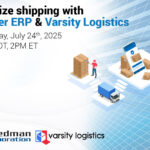
Today’s successful cabinet manufacturers use online cabinet design software to give customers more information, more options, and greater satisfaction in specifying their finished products.
But giving customers lots of options can cause lots of headaches for manufacturing. That’s why it’s essential to connect the data captured online with your inventory levels, back-end production scheduling, and engineering.
Manual Data Transfer Doesn’t Work
No successful company of any scale can compete for long using a manual approach, where the customer data and specifications entered online or submitted via a faxed or emailed order form are then re-entered by a team of order-entry workers. This method is fraught with errors and inefficiencies.
Fortunately, there are three main ways of getting the data from your cabinet design software into your ERP system to expedite and streamline manufacturing. They all work, but there are advantages and limitations to each.
In this post, we’ll delve into the intricate world of translating front-end online ordering information into an efficient manufacturing process, focusing on the niche market of kitchen and bath cabinet manufacturing. The same principles, however, apply to manufacturers of any complex, customized products that are built-, engineered-, or assembled to order.
So whether your customers are selecting cabinet knobs, chair legs, sofa fabric, countertop cutouts, door hardware, window treatments, or equally important industrial equipment that must be built to exact specifications, getting the data from order into production is an essential part of your business.
Data from Cabinet Design Software
In this post, we are talking specifically about the data from online design tools used by your customers, sales reps, or dealers to create a quote or an order. While the term cabinet design software could also refer to the CAD drawing programs that your designers and engineers use to define the products you can build, those designs are foundational to what you can manufacture. That data already exists in your ERP and production department.
Depending on the customer-facing online cabinet design software you select, there may be anything from basic line drawings to colorful, 3d images that change and refresh when a customer changes the specs, selecting a different drawer front or paint finish. And customers DO love to play around with the specs to find the right design that works for them.
When a decision is finally made and the product configured, the next step is to provide pricing and a firm quote that includes timing. This process is often called CPQ for configure, price, quote. And here’s where things can fall apart.
Without accurate and up-to-date pricing, inventory, and scheduling data, many online tools can only provide estimates. That’s why companies work hard to move the data from their online design software to their enterprise system and back.
Three Ways to Move Data from Design to Production
Online cabinet design software has a role in delivering an enhanced customer experience. That only happens when the data transfer can be extended seamlessly to production.
Customer data is entered into the online cabinet design software at the time of ordering. A manufacturing ERP such as Frontier captures comprehensive details about the customer and the configuration choices. That information is matched up with inventory and production schedules, providing real-time visibility and order tracking.
Other than the error-prone manual re-entry of data, here are the three ways manufacturing companies can get their order data from online into production.
1. Electronic Data Exchange
The first method revolves around harnessing the capabilities of popular industry-specific design tools, such as 20/20 cabinet design software. This method creates a seamless transition from design to production by importing the finalized cabinet specifications from the design tool directly into your ERP system. The magic lies in effectively converting customer preferences into manufacturing instructions, ensuring the production of precisely tailored cabinets.
A tool such as Frontier Data Broker facilitates this process with ready-made integration for the most popular cabinet design software tools including 20/20 and others.
Advantages of Electronic Data Exchange
Efficiency
Cabinet design software tools like 2020Insight are optimized for intuitive use and specification capture. A pre-configured connection, such as with Frontier Data Broker, minimizes the likelihood of errors during the data exchange. This, in turn, ensures a smoother production process.
Design Accuracy
The cabinet design software captures intricate details, ranging from materials to dimensions and configurations, and displays them accurately for the customer to see and confirm. This fidelity ensures that the cabinets are manufactured as intended, maintaining design integrity.
Limitations of Electronic Data Exchange
Data Compatibility
Achieving seamless data compatibility between your cabinet design software and your ERP system might require a custom integration effort. Depending on the system in use, this could require technical resources and expertise.
Complex Configurations
In the case of highly intricate configurations, the translation from design tool to ERP might encounter challenges. Complex designs and unique sizes might not translate with absolute accuracy, potentially leading to discrepancies between design and production. In this instance, a product configurator tool that supports parametric configuration might be required over simpler, rules-based product configuration software.
2. ERP with Online Ordering Tool
The second approach to getting online data into production revolves around adopting an ERP system designed with a dedicated online ordering tool, such as Friedman Frontier’s eQuote Dealer. This method empowers customers and dealers to place orders directly through the ERP system. This ensures a direct link between online preferences and manufacturing capabilities.
Advantages of an ERP with CPQ
A Unified System
An online ordering tool within the ERP system eliminates the need for third-party integration. This unified environment simplifies the process to get up and running and reduces potential points of failure.
Real-time Data
Orders placed through the online ordering tool are instantly added to the ERP’s database and relayed to impacted departments, providing real-time insights into order statuses. This transparency is invaluable for monitoring the production pipeline, ensuring sufficient inventory levels, and providing order status.
Limitations of ERPs with CPQ
User Experience
While the online ordering tool streamlines the process, it can lack the feature-rich interfaces of standalone design tools, like 3D cabinet design software. This could potentially impact the user experience for end-customers configuring intricate cabinet details. It often works very well, however, for dealers, architects, and builders who do not need all the bells and whistles of consumer-focused cabinet design software.
Flexibility
Depending on the ERP, the customization options for the embedded online ordering tool might be limited compared to standalone design tools. This could potentially constrain certain design variations or unique customer preferences. Choose an ERP with a parametric product configurator that is more advanced and flexible than a simpler rules-based configurator.
3. API-Based Data Exchange
The third method of getting data from online cabinet design software into your production environment uses Application Programming Interfaces (APIs) to facilitate real-time data exchange between the ERP system and either internally or externally developed web applications.
Advantages of Using APIs
Flexibility
APIs offer an exceptional degree of flexibility, making them ideal for designing customized data exchange solutions in an environment that is completely consistent with your brand. Businesses can tailor the look and feel of the online site precisely to their needs, including the data transfer process.
Scalability
As businesses grow and evolve, APIs can be adapted and extended to incorporate new functionalities seamlessly. This scalability ensures that the solution remains relevant in the face of changing requirements.
Limitations of Using APIs
Development Complexity
Building and maintaining API connections demands technical expertise and resources. It might entail collaboration with internal IT teams or external developers skilled in API integration.
Ongoing Maintenance
Ensuring the continued compatibility and functionality of APIs requires consistent maintenance efforts. This could translate into additional costs and resource allocation.
A solution like eWebServices from Frontier offers a single source of customer, product, pricing, and configuration information so developers can tailor a system to meet your branding, marketing, and customer service needs.
Breaking Free of Manual Data Re-Entry
In many industries, companies still grapple with the inefficiencies and errors associated with manually transcribing customer preferences from online orders into the ERP system. This outdated approach opens the door to transcription errors, miscommunications, and delayed processing times. It’s an arduous process that not only consumes time but also increases the likelihood of inaccuracies that can result in costly production errors, returns, and dissatisfied customers.
The three methods discussed in this article—electronic data exchange from cabinet design software, ERP-integrated online ordering, and API-based data exchange—are all significant leaps above the traditional manual order re-entry process. They offer companies the means to break free from the pattern of manual data transcription to minimize errors, reduce processing times, and ultimately enhance overall manufacturing efficiencies and customer satisfaction.
Selecting the Right Approach
The selection of an approach hinges on your unique manufacturing requirements, existing systems, and operational priorities. There’s no universal “best” method; the choice depends on how well the approach aligns with your company’s processes and objectives.
Friedman’s Frontier ERP software for manufacturers supports all three methods of data transfer with its Data Broker, eQuote Dealer, and eWeb Services modules. Many of today’s leading cabinet companies use cabinet design software tools such as 20/20 that are already integrated with Frontier, using Data Broker to seamlessly transfer the design data.
Others use eQuote Dealer to host their dealer ordering portals, taking advantage of the parametric product configurator at the heart of Frontier. Still, others create their own unique online ordering applications with the addition of eWebServices to ensure seamless integration with their Frontier ERP system.
In Conclusion
In manufacturing complex products, translating order information into efficient manufacturing operations is a pivotal endeavor. The methods discussed—electronic data exchange from popular consumer-facing design software, ERP-integrated online ordering, and API-based data exchange—each come with their distinct set of advantages and limitations.
The crux lies in carefully evaluating these options in the context of your company’s specific requirements. By opting for the method that seamlessly dovetails with your processes, you can achieve streamlined operations, elevate customer satisfaction, and excel in the competitive landscape of custom product manufacturing.
Contact Friedman to learn more or to request a demo of any of the three types of data exchange methods.



